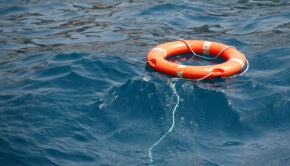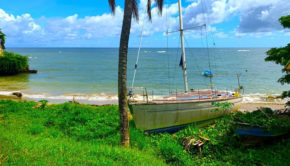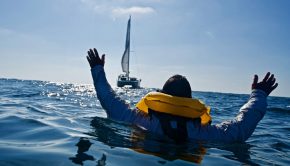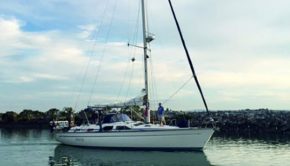Overboard: Stories from off the boat
Published on October 17th, 2019
Falling overboard can occur unexpectedly and end tragically. Staying onboard is always a priority, but even the most experienced can find themselves off the boat. John Kalish shares his episode off the boat:
In mid-November 1984 I took my boat, a Dufour 8.5 from Lisbon to Casablanca for the start later that month of La Transat des Alizés, a mostly Corinthian race to Pointe-a-Pitre, Guadaloupe. Dufour had loaned me the boat for the race: it was hull #1, set up for racing and had been extended to 9.1 meters (30 feet) via a skirt attached to the transom. This proved to be a very valuable addition.
We left Lisbon on a sunny, breezy morning with a forecast of strong northerlies (35-40 knots) for the next day or two — the typical nortada which blows down the Iberian coast in winter. These are normally just strong, steady, clear weather winds and we would let us reach off pretty much on the rhumb line to Casablanca. I had two crew: Bill, an experienced sailor and Pierre, a physical education teacher in great shape but with limited sailing experience.
Once out of the Tagus estuary, the wind increased as expected and by late afternoon we settled into a fast broad reach with a #2 jib, and later, a reef in the main. We were averaging over 10 knots, surfing down the big waves…it was exhilarating. With a steady 25-30 knots, we took a second reef in the main before night fell.
The sky was clear and the stars were out and we enjoyed the fast ride south. By noon the next day the wind increased further, and we changed down to the #3 jib. I wanted a manageable boat during the night, not certain of Pierre’s availability as he had been sick, figuring that Bill and I would have to alternate two-hour watches at the helm until dawn.
Sometime after midnight the waves started to become more irregular. We were well southwest of Cape Saint Vincent, almost due west of the entrance to the Mediterranean and the nortada waves were combining with more westerly swells from the central Atlantic. Now and again a wave would kick our transom. To stabilize the motion, I decided to trail warps. They calmed the boat’s motion and we were still sailing fast.
Bill and I alternated two-hour watches during the night, as expected, with Pierre seasick in his bunk. Towards the end of my last watch, from 06:00 to 08:00 GMT, the wind dropped significantly and the boat was under-powered. The waves remained just as big, however, and now and again our transom got a hard smack and a shove.
I wanted to haul in the warps, but I couldn’t do it with just one hand; I couldn’t let go of the tiller and risk a broach. I had been helming from the leeward (port) side as this allowed me to see the waves coming at us from the starboard quarter. But my right arm was really tired and I had to switch to the windward side and for the last 10 minutes of my watch, looking over my shoulder to read the waves.
However, I didn’t switch my tether, leaving it attached to the portside U-bolt. Bill was sleeping right under me in the starboard aft cabin. I could wake him by simply stamping my foot on the cockpit sole. I pulled back my left foul-weather jacket sleeve to look at my watch. I saw the seconds tick towards 08:00 and at the stroke of the hour I stamped my foot.
I had wanted to let him get his full two hours rest, but I’d taken my eye of the waves for maybe 20 seconds. The last thing I remember was seeing the red toes of my sea boots in sharp relief against the white hull. The shock of the tether coming taut knocked me out and I came to about a 4 or 5 feet under water.
As my tether was on the port side, I had flown over the rail as the boat was knocked down and ended up under the boat as she lay on her side, mast in the water. Fortunately, it was already daylight and I could quickly see where the surface was. Two or three strokes and my head was above the water and took the best breath of my life. The boat started to right herself, but another wave pushed her back down and me with it. When she finally righted herself for good, I grabbed onto the toe rail.
Bill emerged in the companionway and, seeing I wasn’t in the cockpit, looked astern figuring I must be back there somewhere. It became comical as I, with my eyes just above the toe rail, shouted “Bill, I’m here,” while he continued looking astern. By the third shout he looked over and saw me, maybe a 4 feet away.
Pierre came up and the two of them tried to hoist me up over the rail. I couldn’t help much, groggy and weighed down with all the water in my clothes and boots. Finally, I told Bill to attach another tether to mine, make it fast on the backstay, then get mine off its U-bolt and let me float around behind the boat and board via the skirt. It worked. It was an effort but they got me into the cockpit.
We made it to Casablanca the next day, motoring the last 30 or 40 miles as the wind died. When we entered the harbor, I noticed I couldn’t move the helm much to port. After docking a quick check revealed that our rudder stock was bent at about a 30 degree angle.
I never again waited for the end of a watch to get something done which needed doing right away.
——————–
Scuttlebutt wants to feature your overboard experience. Send to editor@sailingscuttlebutt.com.









 We’ll keep your information safe.
We’ll keep your information safe.